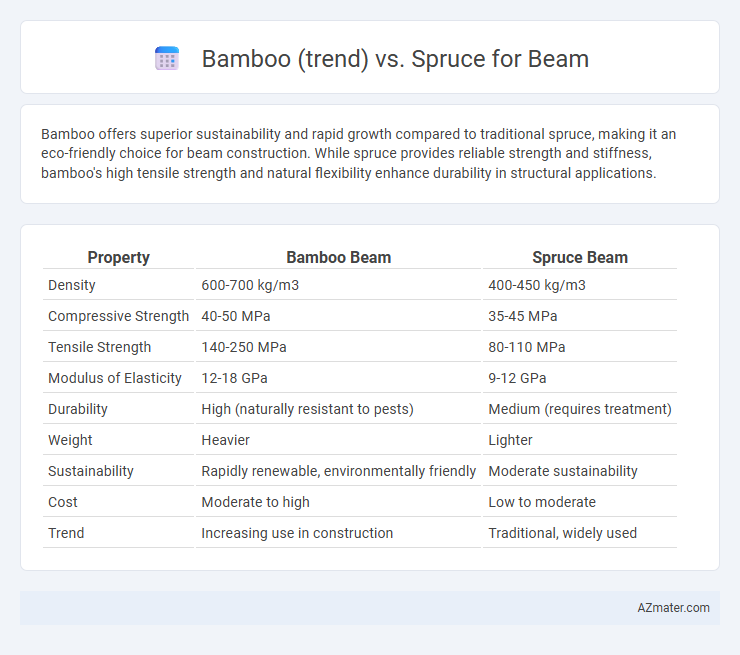Bamboo offers superior sustainability and rapid growth compared to traditional spruce, making it an eco-friendly choice for beam construction. While spruce provides reliable strength and stiffness, bamboo's high tensile strength and natural flexibility enhance durability in structural applications.
Table of Comparison
| Property | Bamboo Beam | Spruce Beam |
|---|---|---|
| Density | 600-700 kg/m3 | 400-450 kg/m3 |
| Compressive Strength | 40-50 MPa | 35-45 MPa |
| Tensile Strength | 140-250 MPa | 80-110 MPa |
| Modulus of Elasticity | 12-18 GPa | 9-12 GPa |
| Durability | High (naturally resistant to pests) | Medium (requires treatment) |
| Weight | Heavier | Lighter |
| Sustainability | Rapidly renewable, environmentally friendly | Moderate sustainability |
| Cost | Moderate to high | Low to moderate |
| Trend | Increasing use in construction | Traditional, widely used |
Introduction: The Rising Trend of Bamboo Beams
Bamboo beams are rapidly gaining popularity as a sustainable and cost-effective alternative to traditional spruce beams in construction. Engineered bamboo offers exceptional tensile strength and flexibility, making it ideal for modern architectural designs that emphasize eco-friendly materials. Unlike spruce, which is susceptible to warping and pest damage, bamboo's natural durability and fast growth rate contribute to its rising demand in green building practices.
Bamboo vs Spruce: Overview and Popularity
Bamboo beams have surged in popularity due to their rapid renewability, high tensile strength, and lightweight characteristics, making them a sustainable alternative to traditional materials. Spruce beams remain favored for their consistent quality, natural stiffness, and cost-effectiveness, widely used in construction and woodworking. Bamboo's unique growth cycle offers environmental benefits, while spruce's widespread availability and well-established market position maintain its dominance in structural applications.
Strength and Durability Comparison
Bamboo beams exhibit exceptional tensile strength, often surpassing traditional wood like spruce due to their fibrous, composite structure that resists cracking under stress. Spruce beams provide consistent compressive strength and superior load-bearing capacity, favored in conventional construction for long spans. Bamboo offers greater natural durability against environmental factors and pests when properly treated, making it a sustainable alternative with enhanced lifespan compared to untreated spruce.
Sustainability and Environmental Impact
Bamboo beams offer exceptional sustainability due to their rapid growth rate, sequestering more carbon dioxide compared to spruce, which takes decades to mature. Bamboo's high strength-to-weight ratio reduces material usage and energy consumption during transportation and installation. Spruce beams, while traditional and widely available, have a larger environmental footprint because of slower regrowth and extensive forestry practices that may impact biodiversity.
Weight and Construction Ease
Bamboo beams weigh significantly less than spruce, with bamboo averaging around 600-700 kg/m3 compared to spruce's 450-500 kg/m3, making bamboo ideal for lightweight construction. Bamboo's natural hollow structure and flexibility allow for easier handling and faster installation on-site compared to the more rigid and dense spruce wood. These properties make bamboo a preferred choice for sustainable, lightweight, and efficient beam applications in modern construction projects.
Cost Analysis of Bamboo and Spruce Beams
Bamboo beams offer a cost-effective alternative to spruce due to their rapid growth rate and higher yield per acre, resulting in lower raw material expenses and reduced harvesting times. Spruce beams generally incur higher costs linked to slower growth, longer maturation periods, and increased transportation and processing fees. When evaluating total lifecycle expenses, bamboo's durability and sustainability factors further enhance its cost advantage over spruce for beam applications.
Aesthetic Differences and Design Applications
Bamboo beams offer a sleek, contemporary aesthetic with a warm golden hue and natural grain patterns that enhance modern and eco-friendly designs. Spruce beams present a lighter, more traditional appearance with a pale color and subtle straight grain, making them ideal for classic or rustic architectural styles. Bamboo's flexibility suits curved or innovative structural elements, while spruce's uniformity supports conventional load-bearing frameworks and exposed timber designs.
Longevity and Maintenance Requirements
Bamboo beams offer exceptional longevity due to their high tensile strength and natural resistance to pests and moisture, requiring minimal maintenance over time. Spruce beams are durable but more susceptible to rot and insect damage, necessitating regular treatment and inspections to maintain structural integrity. In terms of maintenance requirements, bamboo's rapid growth and eco-friendly harvesting further enhance its sustainability and reduce long-term upkeep costs compared to traditional spruce beams.
Availability and Sourcing Challenges
Bamboo beams offer rapid renewability and are widely available in Southeast Asia, but sourcing high-quality, mature bamboo with consistent structural integrity poses challenges due to regional variability and harvesting practices. Spruce beams, sourced predominantly from North American and European forests, benefit from established supply chains and standardized grading systems, ensuring consistent availability but facing sustainability concerns and longer growth cycles. Both materials require careful consideration of local accessibility and environmental impact to optimize sourcing strategies for construction projects.
Conclusion: Which Material Wins for Modern Beam Structures?
Bamboo outperforms spruce in modern beam structures due to its superior tensile strength, rapid renewability, and lighter weight, making it ideal for sustainable construction. Spruce offers consistent quality and ease of machining but falls short in environmental impact and strength-to-weight ratio. Bamboo's combination of ecological benefits and mechanical properties makes it the preferred choice for innovative, eco-friendly beam applications.

Infographic: Bamboo (trend) vs Spruce for Beam
 azmater.com
azmater.com